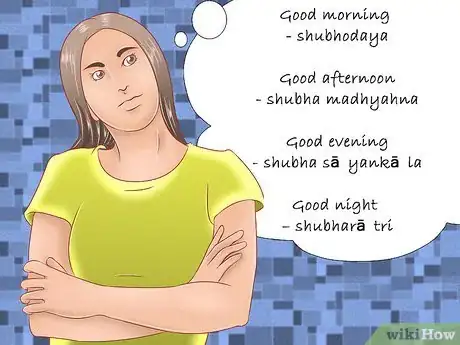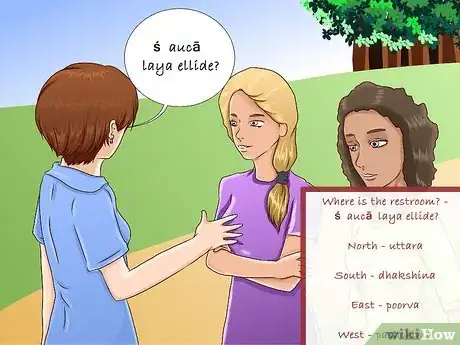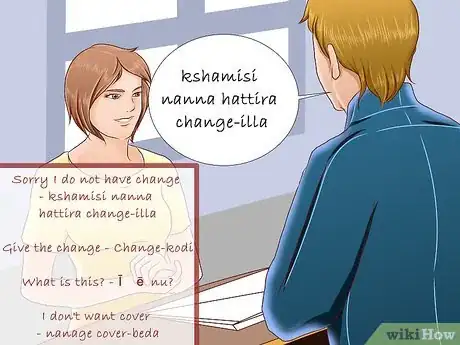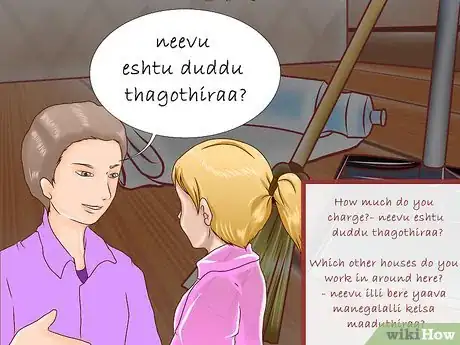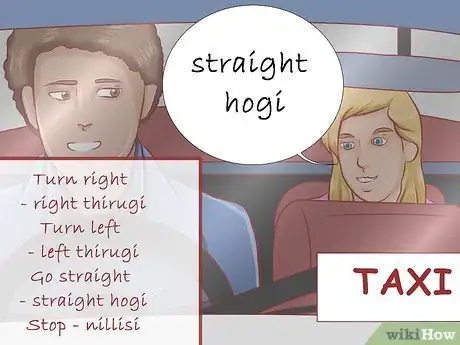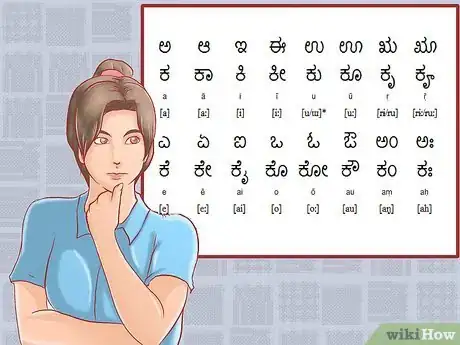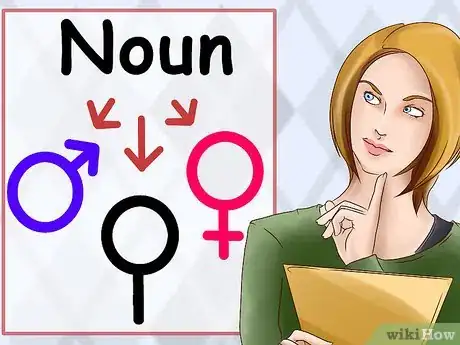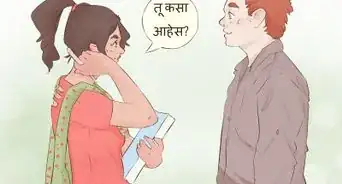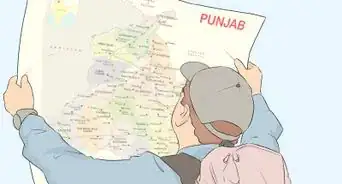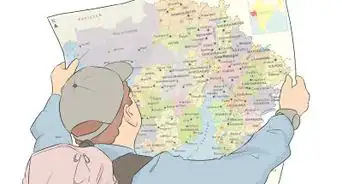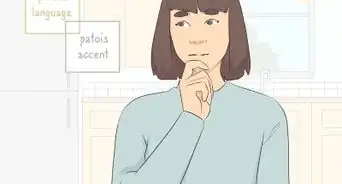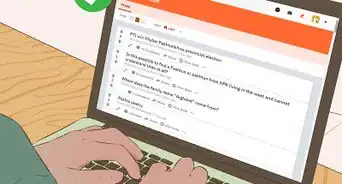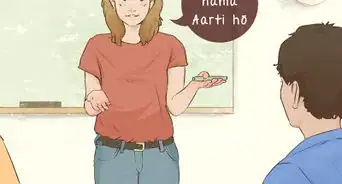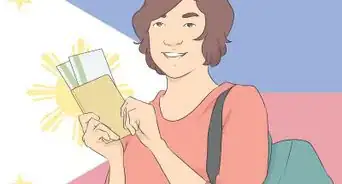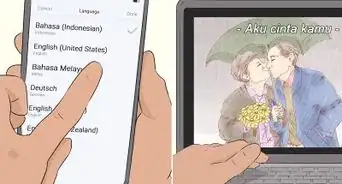wikiHow is a “wiki,” similar to Wikipedia, which means that many of our articles are co-written by multiple authors. To create this article, 29 people, some anonymous, worked to edit and improve it over time.
wikiHow marks an article as reader-approved once it receives enough positive feedback. This article received 21 testimonials and 90% of readers who voted found it helpful, earning it our reader-approved status.
This article has been viewed 327,135 times.
Learn more...
Kannada is a Dravidian language spoken in the state of Karnataka in southern India. Kannadigas, or Kannada (also called Canarese) speakers, are estimated to number around 40,000,000 worldwide. In southern India, there are at least 20 distinct dialects of spoken Kannada. While it is a difficult language to master for English language speakers, it is possible to learn some basic phrases and words that can help you communicate your basic needs in Kannada.
Steps
Engaging in Basic Conversations
-
1Start with the basic greetings. As is the case with most languages, it is useful to begin with greetings and pleasantries that are the most likely to come up in brief interactions with Kannada speakers. Here are some ways to greet, as well as replies to greetings, in Kannada[1] :
- Hello - namaste or namaskāra
- Welcome - susvāgata
- Long time no see - tumba divasagalinda kānisalilla
- How are you? - hegiddērā?
- All is well? – athavā kshemanā?
- I am fine. How are you? - nā calō adīni, nīvu hyāngadīr'ri? or nān cennagiddēne, nīvu hēg'iddīra?
- Pleased to meet you - nimmannu bheti mādiddakke santosha
-
2Use time-specific greetings. In most languages, greetings and salutations change based on the time of day. Kannada is no different. Here are some useful phrases that take the time of the day into account.[2]
- Good morning - shubhodaya
- Good afternoon- shubha madhyahna
- Good evening- shubha sāyankāla
- Good night – shubharātri
Advertisement -
3Introduce yourself. Introducing yourself to strangers is a critical skill to acquire. People will be more willing to help you once you have explained who you are. Here are some ways to do that in Kannada. [3]
- What is your name? (singular) - ninna hesarēnu?
- What is your name? (plural) - nimma hesarēnu?
- My name is … - nanna hesaru ...
- Where are you from? (singular) - nimma ooru yāvudu?
- Where are you from? (plural) - athavā nēvu yāva kadeyavaru?
- I am from … - nā .... linda bandiddīni
- We are from … - nā .... linda bandēni
- Pleased to meet you - nimmannu bheti mādiddakke santosha
-
4Use parting phrases. Here are a few different ways to end a conversation in Kannada. [4]
- Goodbye - hogi banni athavā hogi bartēra?
- Good luck - olleyadāgali athavā shubhavāgali
- Have a nice day - shubha dinavāgali
- Bon voyage - prayana sukhakaravaagirali hogi banni
- See you again - matte sigona
-
5Be polite. When entering a new area with a different culture and language, it is wise to learn the basic pleasantries and phrases of gratitude so that you can show good manners to your hosts. Here are some Kannada phrases that can help you do just that. [5]
- Excuse me – kshamisi
- Sorry - kshamisi
- Please - dayaviṭṭu
- Thank you – dhanyavāda or dhanyavādagaḷu
- Your welcome- yāke summane ṭhanksu? or parwagilla biḍi
- I love you - naa ninna preetisteeni
- Get well soon - bega gunamukharaagi anta haaraisuttene
- Cheers or good health - tumba santosha athavā khushiyāytu
- Enjoy your meal - shubha bhojana athavaa oota enjaay maadi
Asking for Help
-
1Ask for directions. If you are travelling in Karnataka for the first time, or find yourself lost somewhere in southern India, knowing how to ask where something is or where you are is of the utmost importance. Some common phrases include:
- Where is the restroom? - śaucālaya ellide?
- Where is the toilet? - ṭāyleṭ ellide?
- How do i go to the airport? - naanu airport ge hege hoguvudhu?
- Where is … - … ellide or … yelli
- Go straight - neravagi hogi
- Go back - hindhe hogi
- Go right - balagade hogi
- Go left - yedagade hogi
- North - uttara
- South - dhakshina
- East - poorva
- West - pashchima
- Up - mele
- Down - kelage
- Opposite - viruddha
-
2Inquire about products or purchases. When travelling in southern India, it is likely you will want to buy something at one point or another. Here are some phrases that will allow you do that.
- How much is …? – … idhu yeshtu? or … bele eshtu
- Where can I go shopping? – naanu shopping maadalu yelli hoga beku
- What is this? - Ī ēnu?
- Please weigh correctly - dayavittu sariyaagi tooka maadi
- Sorry I do not have change - kshamisi nanna hattira change-illa
- Give the change - Change-kodi
- Please remove damaged / rotten ones - dayavittu damage-aagirodanu thegeyiri
- I don't want cover - nanage cover-beda
- I have a bag - nanna hathira bag-ide
-
3Give orders to domestic help. In southern India, it is not uncommon to see domestic help in many homes and maids are a standard facet at hotels. As such, it is important to be able to speak with the domestic help and, when necessary, give them orders. Some phrases that should be helpful include:
- How much do you charge? - neevu eshtu duddu thagothiraa?
- You are expensive, I can’t afford it - neevu duddu jaasthi keluthira, naanu eshtu koduvudakke aagolla
- Which other houses do you work in around here? - neevu illi bere yaava manegalalli kelsa maaduthiraa?
- What is your mobile number? - nimma mobile number enu?
- Take down my mobile number - nanna mobile number thagolli
- What time can you come? - neevu yaava time-ge baruthiraa?
- Come by … in the morning - neevu belagge … gantege barabeku
- Please be on time - dayavittu time sariyaagi banni
- For sweeping - kasa gudisoke
- For moping - nela oresoke
- For washing clothes - batte ogeyoke
- For washing utensils - paatree tholeyoke
- For cooking - aduge maadoke
- How much would you charge for cooking? - neevu aduge maadoke eshtu duddu thagothiraa?
- How much would you charge for sweeping, moping and washing utensils?- neevu kasa gudisoke, nela oresoke matte paatre tholeyoke eshtu duddu thagothiraa?
-
4Talk to your cab driver. When travelling in southern India, you will most likely take a ride in a cab at some point. Some useful phrases for speaking with your cab driver are :
- Please drive slowly - dayavittu (gaadiyannu) nidhaanavaagi chalaisi
- Turn right - right thirugi
- Turn left - left thirugi
- Go straight - straight hogi
- Stop - nillisi
- Do not talk on phone while driving - drive-maaduvaaga phone maadabedi
- Wear a seat belt - seat belt haakikolli
- Do not jump signals - signal haarisabedi
- Mind the road humps - road naliruva humps nodi (gaadi) chalaisi
- Please wait for 5 minutes, I will come - dayavittu 5 minutes wait-maadi, naanu baruthene
- Come on time tomorrow - naale time sariyaagi banni
-
5Learn some general questions and phrases. There are common phrases and questions that are important to know in any language when you intend to travel to where that language is spoken. Here are some phrases and questions in Kannada that could be helpful to you.
- How do I go there? - allige naanu hege hoguvudu?
- Where is your house? - nimma mane elli idhe?
- Where is the nearest police station? - hathiradha police station yelli idhe?
- Where can i go shopping? - naanu shopping maadalu yelli hoga beku
- Can you help me? - nanage sahaaya maaduvira?
- What are you doing? - neevu yenu maaduthidheera?
- Would you join me for lunch today? - eedina nanna jothe oota maduvira?
- How do I go to the airport? - naanu airport ge hege hoguvudhu?
- Where shall we meet? - naavu yelli bheti aagoNa?
- Was there a call for me? - nanage yaraadharu call maadidhara?
- What did you do? - neenu yenu maadiruve ?
- What will you do? - neenu yenu maaduthiya?
- What should I do? - naanu yenu maadabeku?
- What can I do? - naanu yenu madabhahudu?
- Whom should I contact? - naanu yarannu samparkisabeku?
- Will you come with me? - neenu nanna jothege baruveya?
- I shall come with you - naanu ninna jothege baruve
- Did you have your lunch? - oota maadideya?
- Are you busy? - neenu busy idhiya?
- I am busy now - naanu eega busy ideeni
-
6Get assistance with your use of Kannada. While you have taken the time to learn some of the common phrases in Kannada that will help you get around, you will most likely need further assistance in saying or writing things in the language from native speakers. Some phrases and questions that can assist you with this are[6] :
- I don’t understand - tiḷī'lilla or nanag artha āg'lilla
- Please speak more slowly - salpa mellage mātāḍi or salpa nidhāna'vāgi mātāḍi
- Please say that again - innomme hēḷi or inn'ond'sala hēḷi
- How do you … in Kannada? - kannadadalli … hege helodu?
- Do you speak Kannada? - neevu kannada maataadteera?
- Do you speak English? - neevu english maataadteera?
- Yes, I speak a little - houdu, svalpa svalpa barutte
- Please write that down - bared' koḷḷ'ri
Understanding the Basics of Kannada
-
1Learn the alphabet. Kannada's alphabet is derived from Kadamba and Cālukya scripts that, over centuries, morphed in Kannada and Telugu scripts. These scripts were formalized and translated into English script forms in the 19th century.[7]
- Here is a chart of Kannada vowels and their pronunciation.
- ಅ a KANNADA LETTER A
- ಆ ā KANNADA LETTER AA
- ಇ e KANNADA LETTER E
- ಈ e KANNADA LETTER EE
- ಉ u KANNADA LETTER U
- ಊ ū KANNADA LETTER UU
- ಋ r̥ KANNADA LETTER VOCALIC Ru
- ೠ r̥̄ KANNADA LETTER VOCALIC RR
- ಎ i KANNADA LETTER e
- ಏ ii KANNADA LETTER AE
- ಐ ai KANNADA LETTER AI
- ಒ o KANNADA LETTER O
- ಓ ō KANNADA LETTER OO
- ಔ au KANNADA LETTER AU
- Canarese consonants come in two forms, structured and unstructured. Structured consonants are categorized by where the tongue touches the palate. These come in five categories. They are:
- Velars ಕ (ka) ಖ (kha) ಗ (ga) ಘ (gha) ಙ (nga)
- Palatals ಚ (cha) ಛ (chha) ಜ (ja) ಝ (jha) ಞ (nya)
- Retroflex ಟ (tta) ಠ (ttha) ಡ (dda) ಢ (ddha) ಣ (nna)
- Dentals ತ (ta) ಥ (tha) ದ (da) ಧ (dha) ನ (na)
- Labials ಪ (pa) ಫ (pha) ಬ (ba) ಭ (bha) ಮ (ma)
- The unstructured consonants are: ಯ (ya), ರ (ra), ಲ (la), ವ (va), ಶ (sha), ಷ (ssa), ಸ (sa), ಹ (ha), ಳ (lla)
- Kannada also includes two letters which are part consonant and part vowel, called "yogavaahaka". They are the anusvara: ಅಂ (am) and the visarga: ಅಃ (ah)
-
2Learn Kannada numbers. The Kannada language has a numbering system that stretches from 0 to 1 million.[8]
- Below is a sample of Kannada numbers from 0 to 9.
- ೦ sonne 0 Zero
- ೧ ondu 1 One
- ೨ eraḍu 2 Two
- ೩ mūru 3 Three
- ೪ nālku 4 Four
- ೫ aidu 5 Five
- ೬ āru 6 Six
- ೭ ēḷu 7 Seven
- ೮ enṭu 8 Eight
- ೯ oṃbattu 9 Nine
-
3Know the Kannada writing system. The Kannada language is alphasyllabary, which means all the consonants have an inherent vowel sound in them. Just like English, Canarese moves from left to right horizontally. When consonants appear together without a vowel in between, the second consonant is written as a special conjunt symbol, usually below the first.[9]
- When Kannada is written using English language characters, you will sometimes find that vowels in the middle of words are capitalized to represent the long vowel sound. However, this convention is not uniformly practiced.
-
4Know the common pronouns. Understanding basic pronouns is essential to speaking or comprehending languages. Below is a list of Kannada pronouns.[10]
- I - naanu
- you - neenu
- he - avanu
- she - avalu
- we - naavu
- they -avvaru
- me - nanna, nannage
- you - ninna, nimage
- him - avana, avanige
- her - avala,avalige
- us - namma
- them - avarige
- my - namma
- your - ninna
- his - avana
- her - avala
- our - namma
- their - avara
- mine - nanna
- yours - nimma
- his - avana
- hers - avala
- ours - namma
- theirs - avara
-
5Learn Kannada pronunciation. The pronunciation of certain Kannada words can be difficult for English speakers, as there are some sounds in Canarese for which English has no equivalent. Nevertheless, the pronunciation guide below should be useful in grasping the basics of pronouncing Kannada words.
- Ane (here A is as in Ball). In contrast, in aDike a is short as in "aristocrat".
- mEle (here E is as in Baby).
- prIti (here I is as in Meeting)
- hOda (here O is as in roam)
- pUjari (here U is as in fool)
- The consonants which are capitalized are:
- aDike (the D is as in "Dog"); lower case d is soft).
- koTru (here T is as in "Tom"); lower case is soft.
- chELige (here L is a sound with no equivalence in English; lower case is as in "lamb")
- kaNNu (here N is nasal; lower case is as in "no")
-
6Understand gendering conventions. All Kannada nouns have genders. There are three categories of gender applied to nouns in Kannada. They are masculine, feminine, and neuter. This can be tricky for English speakers, as English nouns are not gendered, and elements of Kannada religion and cosmology play a role in the gendering of nouns.[11]
-
7Understand Kannada verbs. Kannada, unlike western languages, does not have infinitive forms for its verbs. Rather, they take the form of "singular, nonpolite imperatives."[12] In most cases, unconjugated verbs take the form of verb stems.[13]
- Because of this, when looking at a Kannada language dictionary, you will find verbs by their verb stem rather than in a constructed, infinitive form. For example, see the conjugation of "to walk" in Kanadda below.
- to walk - naḍeyalu
- I walk - nānu naḍeyuttēne
- you walk - nīvu naḍeyalu
- he walks - avaru paricayisuttade
- she walks - avaḷu naḍedu
- it walks - idu paricayisuttade
- they walk - avaru naḍedu
- we walk - nāvu naḍeyalu
- Notice that all of the conjugated forms maintain the root "ade" somewhere in the word.
Community Q&A
-
QuestionHow do I ask "When did you come?" in Kannada?
 Community AnswerIf you want to say "When did you come?", you would say ನೀವು ಯಾವಾಗ ಬಂದಿರಿ ("Nīvu yāvāga bandiri").
Community AnswerIf you want to say "When did you come?", you would say ನೀವು ಯಾವಾಗ ಬಂದಿರಿ ("Nīvu yāvāga bandiri"). -
QuestionHow can I use practical conversation to help me learn how to pronounce properly?
 Community AnswerKeep writing it down or keep on saying it, or ask someone who knows how to pronounce it.
Community AnswerKeep writing it down or keep on saying it, or ask someone who knows how to pronounce it. -
QuestionHow do I say, "I am there for you, don't worry," in Kannada?
 Community AnswerYou say, "nannu nin jothe idhini neenu chinthe madu beda."
Community AnswerYou say, "nannu nin jothe idhini neenu chinthe madu beda."
References
- ↑ https://www.villagevolunteers.org/wp-content/uploads/2011/11/Kannada-Language-Guide.pdf
- ↑ https://www.villagevolunteers.org/wp-content/uploads/2011/11/Kannada-Language-Guide.pdf
- ↑ http://www.omniglot.com/language/phrases/kannada.php
- ↑ http://www.omniglot.com/language/phrases/kannada.php
- ↑ http://www.omniglot.com/language/phrases/kannada.php
- ↑ http://www.omniglot.com/language/phrases/kannada.php
- ↑ https://www.villagevolunteers.org/wp-content/uploads/2011/11/Kannada-Language-Guide.pdf
- ↑ https://www.villagevolunteers.org/wp-content/uploads/2011/11/Kannada-Language-Guide.pdf
- ↑ http://www.omniglot.com/writing/kannada.htm
About This Article
To speak in Kannada, start by learning some basic phrases, like “Namaste” to say “Hello,” or “”Hegiddērā,” which means, “How are you?’ Then, use the phrase, “Nanna hesaru,” followed by your name to introduce yourself. You should also use pleasantries like, “Kshamisi,” meaning “Sorry” or “Dhanayavāda” to say “Thank you.” When parting ways, try saying, “Hogi banana athavā hogs bartēra?” to say goodbye, or “Matte sigona,” which means “See you again!” For tips on how to ask for help in Kannada, read on!

